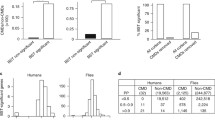Summary
In species where actin genes exist as single copies, analysis of their synonymous codon usage and of the substitutions occurring between the genes of closely related species shows that there is a positive selection for codons that do not have highly mutable CpG dinucleotides in codon positions 2 and 3 when the GC content of these genes is less than 57%.
Similar content being viewed by others
References
Bird AP (1986) CpG-rich islands and the function of DNA methylation. Nature 321:209–213
Cupples CG, Pearlman RE (1986) Isolation and characterization of the actin gene fromTetrahymena thermophila. Proc Natl Acad Sci USA 83:5160–5164
Deshler JO, Larson GP, Rossi JJ (1989)Kluveromyces lactis maintainsSaccharomyces cerevisiae intron-encoded splicing signals. Mol Cell Biol 9:2208–2213
Dudler R (1990) The single-copy actin gene ofPhytophthora megasperma encodes a protein considerably diverged from any other known actin. Plant Mol Biol 14:415–422
Fidel S, Doonan JH, Morris NR (1988)Aspergillus nidulans contains a single actin gene which has unique intron locations and encodes a γ-actin. Gene 70:282–293
Gallwitz D, Sures I (1980) Structure of a split yeast gene: complete nucleotide sequence of the actin gene inSaccharomyces cerevisiae. Proc Natl Acad Sci USA 77:2546–2550
Green PM, Montandon AJ, Bentley DR, Ljung R, Marie Nilsson I, Giannelli F (1990) The incidence and distribution of CpG→TpG transitions in the coagulation factor IX gene. A fresh look at mutational hotspots. Nucleic Acids Res 18:3227–3231
Hanai R, Wada A (1988) The effects of guanine and cytosine variation on dinucleotide frequency and amino acid composition in the human genome. J Mol Evol 27:321–325
Hirono M, Endoh H, Okada N, Numata O, Watanabe Y (1987)Tetrahymena actin. Cloning and sequencing of theTetrahymena actin gene and identification of its gene product. J Mol Biol 194:181–192
Li W-H, Luo C-C, Wu C-I (1985) Evolution of DNA sequences. In: MacIntyre RJ (ed) Molecular evolutionary genetics. Plenum, New York, pp 1–94
Losberger C, Ernst JF (1989) Sequence of theCandida albicans gene encoding actin. Nucleic Acids Res, 17:9488
Mertins P, Gallwitz D (1987) A single intronless actin gene in the fission yeastSchizosaccharomyces pombe: nucleotide sequence and transcripts found in homologous and heterologous yeast. Nucleic Acids Res 15:7369–7379
Russell GJ, Walker PMB, Elton RA, Subak-Sharpe JH (1976) Doublet frequency analysis of fractionated vertebrate nuclear DNA. J Mol Biol 108:1–23
Savatier P, Trabuchet G, Faure C, Chebloune Y, Gouy M, Verdier G, Nigon VM (1985) Evolution of the primate β-globin gene region. High rate of variation in CpG dinucleotides and in short repeated sequences between man and chimpanzee. J Mol Biol 182:21–29
Wildeman AG (1988) A putative ancestral actin gene present in a thermophilic eukaryote: novel combination of intron positions. Nucleic Acids Res 16:2553–2564
Author information
Authors and Affiliations
Rights and permissions
About this article
Cite this article
Drouin, G. Nonrandom CpG mutations affect the synonymous codon usage of moderately GC-rich single copy actin genes. J Mol Evol 33, 237–240 (1991). https://doi.org/10.1007/BF02100674
Received:
Accepted:
Issue Date:
DOI: https://doi.org/10.1007/BF02100674




